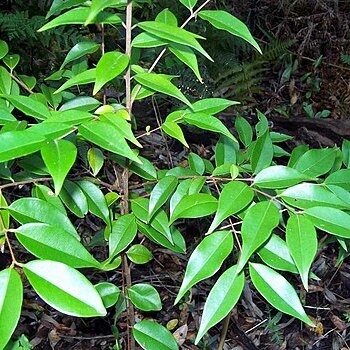Shrub or tree, 1.5–20 (–30) m high. Bark rough, flaky to fissured. New leaf shoots and stems silvery silky (covered with long fine whitish hairs). Branchlets short-sericeous to villous (very hairy on new growth, becoming sparsely hairy and glabrescent with age). Leaves opposite, simple; lamina ovate to lanceolate, elliptic-ovate or elliptic to narrowly elliptic, (20–) 28–80 mm long, (8–) 12–37 (–40) mm wide, ± attenuate to cuneate base, entire, recurved to slightly revolute margin, acuminate apex, subcoriaceous, discolorous, at first sericeous then sparsely hairy to glabrous and shiny above, sparsely to (especially along midvein) moderately hairy to glabrous and paler green below, densely covered with minute oil glands (seen with 10 × lens), midvein raised on lower surface of lamina, lateral veins faint to inconspicuous; petiole (3–) 4–7 mm long, hairy. Inflorescences mostly axillary. Hypanthium sericeous throughout (sometimes densely). Calyx lobes (4 or) 5, to c. 1 mm long. Petals (4 or) 5, 3–5 mm long, white (to cream), marked by oil glands. Stamens 40–80; filaments c. 2–3 mm long, usually white; anther connective with a terminal gland. Ovary (3–) 4 (–5)-locular. Stigma small, capitate. Berry ± globose to subglobose, (4–) 6.5–7.5 mm long, (4–) 8–10 mm wide (3–8 mm diam., in litt.), somewhat constricted along locular walls, purplish to black at maturity, crowned by calyx lobes. Seeds usually c. 8–10.
More
A small tree. It grows 4-8 m tall. It can reach 25 m tall and have a trunk 45 cm across. The trunk is often crooked. The ripe fruit are black. The leaves are 2-8 cm long and 1.5-3 cm wide. The leaves are opposite, entire and oval. The fruit is a round, black berry. It has about 10 seeds.
Cultivated as ornamental or hedge plant, for its shiny green foliage, colourful new growth, often somewhat weeping habit, profuse fragrant flowers visited by bees and other insects, and edible berries which are taken by birds.
More
The ripe fruit are eaten raw.


